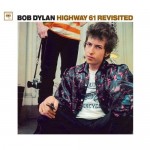Bob Dylan took only six days to record Highway 61 Revisited, the last being August 4, 1965. What did he accomplish in those six days? Well, the album itself ranked fourth in Rolling Stone‘s list of the 500 Greatest Albums of All Time. The opening track, “Like A Rolling Stone,” tops the magazine’s list of the 500 Greatest Songs of All Time. Two other songs — “Desolation Row” and the title track — ranked 185 and 364, respectively on that same list.
 In March 1965, Bringing It All Back Home revealed Dylan was venturing into “electric music.” The first side of that LP was recorded with an electrically amplified rock band. By mid-June 1965 Dylan was back in the studio. And by the time Dylan Highway 61 Revisited was released in August, it was clear there was no going back.
In March 1965, Bringing It All Back Home revealed Dylan was venturing into “electric music.” The first side of that LP was recorded with an electrically amplified rock band. By mid-June 1965 Dylan was back in the studio. And by the time Dylan Highway 61 Revisited was released in August, it was clear there was no going back.
During the June recording sessions, Dylan was accompanied by rock musicians. Among the songs they recorded was “Like A Rolling Stone,” which was actually released as a single on July 20, 1965, before Dylan returned to the studio to complete the LP. It also was one of three electric songs Dylan would play at the Newport Folk Festival on July 25, 1965, something Rolling Stone named as one of the 50 moments that changed rock history. The song, which one Dylanologist called Dylan’s “vomitific masterpiece,” would reach number 2 on the pop charts by August, the first song performed by Dylan to crack the top 10.
Following his historic reception/rejection at Newport, Dylan returned to the studio in late July and early August to complete the album. The tracks cut then included the socially biting title cut and “Ballad of a Thin Man,” both electric tunes. On August 2, 1965, Dylan recorded an electric version of “Desolation Row.” Two days later, though, it was cut in the last session with just Dylan and Charlie McCoy on acoustic guitars. Two of the day’s eight takes were spliced together to create what I consider to be a masterpiece. I still remember the first time I heard it. When it ended I sat there, awed by what I had just heard. It perhaps as much as anything made me a Dylan fan.
The tone of the song is set with the opening lyric: “They’re selling postcards of the hanging.” For the next 11 minutes Dylan takes us on a dizzying trip through a bizarre circus/carnival world full of literary allusion, with references ranging from Ezra Pound and T.S. Eliot to Opehlia, Robin Hood and the Hunchback of Notre Dame. In the course of one verse, Dylan can combine social commentary (“Now at midnight all the agents/And the superhuman crew/Come out and round up everyone/That knows more than they do”) and capitalism critique (“Then they bring them to the factory/Where the heart-attack machine/Is strapped across their shoulders”). While “Desolation Row” became a staple in Dylan’s live repertoire and the original electric version officially surfaced four years ago on No Direction Home: The Soundtrack (The Bootleg Series Vol. 7).
Some read a lot into the fact it is the only acoustic tune to make the album and that it closes it. “Desolation Row,” Rolling Stone said, was “a spellbinding new vision of folk music to close the album that, for the time being at least, destroyed folk music. The gesture was simultaneously touching and a devastating ‘Fuck you!'”
As accurate as that may be Rolling Stone made another comment with which I fully agree because of the impact “Desolation Row” had on me. Highway 61 Revisited, it said, “is one of those albums that, quite simply, changed everything.”
And the only sound that’s left
After the ambulances go
Is Cinderella sweeping up
On Desolation Row
Bob Dylan, “Desolation Row,” Highway 61 Revisited







